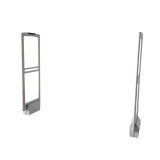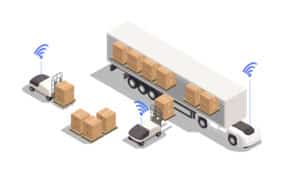In today’s fast-paced world of logistics, efficiency and accuracy are key. As businesses strive to streamline their operations and improve supply chain management, advanced technologies like RFID tracking stickers have emerged as game-changers. These innovative stickers, embedded with RFID (Radio Frequency Identification) technology, enable businesses to track and manage their inventory in real-time. In this article, we will explore the benefits of using RFID tracking stickers in B2B logistics and how they can be customized to meet the unique needs of businesses.
The power of RFID tracking stickers
RFID tracking stickers have revolutionized the way businesses manage their inventory and logistics. Here are some of the key advantages they offer:

- Real-Time tracking: With RFID labels, businesses can accurately track the movement of their assets in real-time. This allows for better visibility across the supply chain, reducing the risk of lost or misplaced items.
- Increased efficiency: By automating the tracking process, RFID stickers eliminate the need for manual data entry, reducing human error and saving valuable time. This leads to increased operational efficiency and improved productivity.
- Enhanced inventory management: RFID stickers enable businesses to have accurate and up-to-date information about their inventory levels. This allows for better inventory management, minimizing stockouts or overstock situations.
- Theft prevention: The use of RFID stickers acts as a deterrent to theft and unauthorized access. In the event of any suspicious activity, businesses can quickly identify and locate missing items, mitigating potential losses.
- Seamless integration: RFID stickers can be easily integrated with existing logistics systems, making the implementation process smooth and hassle-free. They can be customized to work with different types of assets, including pallets, containers, and individual products.
Customizing RFID tracking stickers for B2B logistics
To maximize the benefits of RFID tracking stickers in B2B logistics, it’s essential to customize them to suit the unique requirements of businesses. Here are some key factors to consider when customizing RFID tracking stickers:

- Compatibility: Ensure that the RFID stickers selected are compatible with the existing infrastructure and logistics systems of the business. This includes compatibility with the RFID readers and software used for data collection and analysis.
- Durability: B2B logistics often involves the transportation and handling of goods, which can subject RFID stickers to various environmental conditions. It is essential to select stickers that are durable and resistant to factors like moisture, temperature variations, and physical damage.
- Data storage capacity: Different RFID stickers have varying data storage capacities. Consider the specific information that needs to be stored and tracked for inventory management or other purposes. Select stickers that offer sufficient data storage to meet the business’s needs.
- Size and placement: Depending on the nature of the assets being tracked, the size and placement of RFID tracking stickers may differ. Customization should take into account the appropriate size and optimal placement of stickers to ensure efficient reading and minimize interference.
- Integration with business processes: Customizing RFID tracking stickers to seamlessly integrate with existing business processes is crucial. This includes integrating the tracking data into inventory management systems, logistics software, or other relevant platforms for efficient data analysis and decision-making.
Customization options
RFID tracking stickers can be customized in various ways to meet the specific needs of B2B logistics. Some customization options include:
- Branding: Businesses can customize RFID tracking stickers with their logo or branding elements to enhance brand visibility and recognition. This can also help differentiate the business’s assets from others in a shared logistics environment.
- Data encoding: RFID tracking stickers can be encoded with specific data fields to track unique information related to the assets being monitored. This can include SKU codes, serial numbers, batch numbers, or other relevant data points for better inventory control.
- Range and readability: Customization can involve adjusting the read range of the RFID tracking stickers to cater to the specific logistics environment. This ensures optimal readability while preventing interference with neighboring tags.
- Security features: To enhance security, RFID tracking stickers can be customized with encryption or authentication protocols, safeguarding the tracking data from unauthorized access or tampering.
- Form factors: Different assets may require different form factors for RFID tracking stickers. Customization allows businesses to select the appropriate size, shape, and attachment method for the stickers based on their specific logistics requirements.
By considering these factors and exploring customization options, businesses can customize RFID tracking stickers to align with their unique needs and optimize B2B logistics operations.
Conclusion
In conclusion, customizing RFID tracking stickers for B2B logistics is an effective way to enhance asset management and streamline business processes. By considering factors like compatibility, durability, data storage capacity, size and placement, and integration with business processes, businesses can tailor RFID tracking stickers to their specific needs. Customization options such as branding and data encoding further enable businesses to optimize asset tracking and inventory management.
By embracing the customization possibilities of RFID tracking stickers, businesses can improve efficiency, reduce costs, and enhance overall logistics operations. So, don’t miss out on the benefits of customized RFID tracking stickers for your B2B logistics needs. Start exploring your options today and unlock the full potential of asset management in your business.
FAQs
1. Can RFID stickers be tracked?
Yes, RFID stickers can be tracked. They contain a unique identifier that can be read by RFID readers, enabling the tracking of items or assets to which the stickers are attached. The tracking is done wirelessly using radio frequency identification technology. This capability makes RFID stickers valuable for applications such as inventory management, supply chain logistics, and asset tracking, where real-time monitoring and traceability are essential.
It’s important to note that the tracking range and method may vary depending on the type of RFID technology used (passive or active) and the specific characteristics of the RFID system in place.
2. Do RFID stickers work?
Yes, RFID stickers work effectively. These stickers are equipped with radio frequency identification (RFID) technology, which enables them to wirelessly transmit data to RFID readers. RFID stickers find wide applications in industries such as logistics, retail, and security for tracking and managing inventory, enhancing supply chain visibility, and improving security measures.
The reliability and functionality of RFID stickers make them valuable tools for automating processes, reducing errors, and increasing efficiency in various business operations.
3. How accurate is RFID tracking?
RFID tracking is highly accurate. The technology allows for real-time and precise monitoring of items equipped with RFID tags. Accuracy is influenced by factors like the type of RFID system (passive or active), tag quality, and the environment in which tracking occurs. In optimal conditions, RFID systems can achieve near-perfect accuracy, providing a reliable solution for inventory management, asset tracking, and other applications.
However, factors like interference, distance from the RFID reader, and environmental obstacles can impact accuracy. Despite these considerations, RFID tracking is known for its efficiency and is widely used in various industries to improve visibility and streamline operations.
4. How far can RFID be tracked?
The tracking range of RFID depends on the type of RFID technology used—passive or active—and the specific characteristics of the RFID system.
- Passive RFID: Typically has a shorter range, commonly up to a few meters. The RFID reader sends out a signal to power the passive RFID tag, and the tag responds with its data.
- Active RFID: Can have a longer range, extending to tens of meters or even over a hundred meters. Active RFID tags have their own power source, allowing them to transmit signals independently and over greater distances.
The tracking range can be influenced by environmental factors, interference, and the power of the RFID reader. It’s essential to consider these factors when designing an RFID system for a particular application.


































